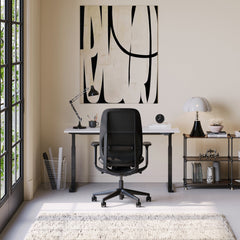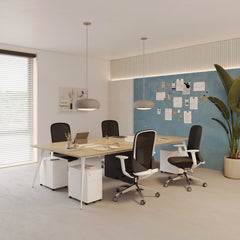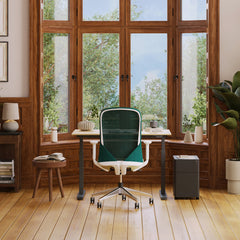Get 10% off your first order
Find the office furniture that’s designed to match your style, comfort, and needs perfectly. Subscribe
Beyond Desks and Chairs: How Cohesive Design Shapes Your Office Brand

Visit quiz page to see how we makes it easy to create an inspiring workplace

Sitting is not passive. Muscles, joints, and connective tissues stabilize the spine while the eyes and hands coordinate with screens and devices. When a chair fits the body, neutral alignment becomes the default, not an effort. Evidence-informed guidance such as the NIOSH guidance on workplace ergonomics emphasizes neutral postures, adjustability, and task fit. A premium chair earns its keep by helping users maintain a natural S-curve through the lumbar region, distributing pressure across the seat, and allowing micro-movements that prevent stiffness.
Discomfort steals attention in tiny increments. Pressure points lead to fidgeting, fidgeting disrupts focus, and the cycle repeats. Premium seating counters this cycle with targeted lumbar support, stable recline control, and materials that regulate heat. The result is steadier concentration, fewer posture corrections, and less end-of-day fatigue. Budget thinking that prioritizes comfort and fit, rather than brand prestige, delivers reliable gains for knowledge work and creative tasks alike.

Chairs do not succeed because of a single feature. Value comes from the interplay of a well-shaped backrest, tuneable mechanisms, supportive foam or mesh, and a frame that stays true under daily load. Replaceability of parts, serviceability, and a no-nonsense warranty are additional signals that a chair is designed for years of use rather than quick turnover.
Use the following framework to weigh categories on substance, not hype.
| Category Label | Structural Integrity | Adjustability Depth | Breathability | Serviceability Potential |
|---|---|---|---|---|
| Entry Office Chair | Basic frame stability | Limited or fixed | Low to moderate | Minimal parts support |
| Mid-Segment Ergonomic | Reinforced frame | Core adjustments present | Moderate to high | Some replaceable components |
| Premium, Budget-Conscious | Rigid frame with quality fasteners | Full seat, arm, and recline tuning | High airflow or pressure-smart foam | Thoughtful parts access and clear support |
A feature only matters if it changes how the body sits. Look for adjustments that are easy to reach and that stay put after you set them.
Thighs should rest parallel to the floor with feet flat. A seat that is too high compresses the back of the legs. A seat that is too shallow or too deep causes slouching or edge pressure. Shorter users often benefit from more height range and a shorter seat pan. Taller users benefit from deeper seat options or sliding seat mechanisms.
Adjustable lumbar height and firmness let the backrest support the natural inward curve. Fixed bulges that do not align with the user’s lower back create pressure and encourage slouching. Seek a back that follows you during recline so support remains consistent.
Arms should relax at the sides with elbows near 90 degrees. Height, width, and pivot let the arm pads meet the forearm without forcing the shoulders upward. Stable pads reduce soft-tissue irritation during extended typing.
Smooth recline encourages position changes without breaking concentration. Tension control should match body weight, and multi-position stops help during focused tasks. A synchronized mechanism that shifts seat and back in relation maintains contact through movement.
Quality mesh distributes pressure across a wide area and allows airflow. It should feel firm enough to hold posture, yet flexible enough to adapt as you move. Look for fine, tight weaves and even tension across the back.
High-resilience foam springs back after pressure is removed. The seat should feel supportive across the entire surface, including edges. A waterfall front edge reduces leg pressure during long sessions.
Metal reinforcement and high-grade fasteners resist wobble. Nylon or metal bases with smooth casters glide without chatter. On hard floors, soft casters protect surfaces and reduce noise.
Measure popliteal height, the distance from the back of the knee to the floor, to guide seat height. Measure seat depth preference by ensuring two to three fingers of space between the seat edge and the back of the knee. Note desk height and keyboard tray position to set armrest height. These measurements prevent guesswork that often leads to buyer’s remorse.
Sit, then set: height, seat depth, lumbar height, lumbar firmness, arm height, arm width, arm pivot, and recline tension. Type for several minutes, then reach for a notebook or phone. If the chair encourages a neutral posture without constant micro-corrections, the fit is close. If you feel pressure behind the knees or at the shoulder blades, retune or consider a different back profile.
Chairs in this group rely on supportive geometry rather than gimmicks. The an ergonomically refined Novo model built for posture precision illustrates this approach with a back that tracks movement and controls that make fine adjustments simple. The emphasis is on reliable tuning, not flashy extras, which aligns with budget goals that put comfort first.
Dynamic work needs a back that follows through. The adaptive support of the Onyx chair is purpose-built for users who shift between typing, calls, and reading. Synchronized recline keeps the lumbar region engaged while preserving a steady visual field for screen work.
A workspace still deserves character. The artistic comfort of the Muse design blends a sculpted profile with supportive contours. It suits studios and hybrid spaces where aesthetics, movement, and comfort all matter.
Smaller rooms and hot-desking require agility. The minimalist durability of the Seashell model offers a light footprint and a structure that feels composed under daily use. It fits tight layouts without sacrificing posture support.
Use cases help narrow choices quickly:
Focused typing and analysis: prioritize lumbar height and firm seat support.
Creative collaboration: emphasize fluid recline and armrest pivot.
Mixed tasks all day: favor synchronized mechanisms and breathable materials.
Small spaces or shared seating: choose maneuverability and compact back profiles.
Inventory refreshes and model updates create natural windows for value. The most reliable approach is to shortlist viable chairs based on fit and features, then act when your preferred configuration becomes available. Focus on alignment with your measurements and work pattern rather than temporary promotions.
If you are furnishing more than one piece, use the custom bundle savings that stretch your furniture budget further option to align chair and desk choices in one plan. Bundling helps maintain consistent ergonomics, reduces decision friction, and simplifies logistics.
Warranty terms reveal how a brand views its own engineering. Clear coverage for structural components, mechanisms, and textiles is a positive sign. Straightforward return policies reduce risk and support fit testing at home.
Large marketplaces can obscure quality behind endless listings. A targeted selection such as the curated chairs collection simplifies comparison and keeps attention on essentials like adjustability, breathability, and frame stability.
A well-set chair cannot compensate for a desk that is too high or a monitor that is too low. Arms should land lightly on arm pads with wrists straight to the keyboard. Screens should meet eye level without neck craning. Consider stable desk surfaces and clean cable routing to preserve movement freedom.
A compatible desk elevates the value of your chair. For inspiration across sizes and finishes, explore the modern desk collection and align leg clearance, work surface depth, and monitor placement with your chair’s posture profile.
Chairs with compact back heights and smooth casters move easily between zones. When rooms double as living areas, neutral finishes and simple silhouettes allow a professional look during work hours and visual calm after hours.
Tighten fasteners periodically, especially at arms and mechanisms. Vacuum mesh and fabric to prevent dust abrasion. Inspect casters for debris that affects rolling. Small maintenance habits preserve smooth posture transitions and keep the chair stable.
1. Set seat height so feet rest flat and thighs are parallel.
2. Adjust seat depth for a two-finger gap behind the knees.
3. Raise lumbar support until it meets the lower back curve.
4. Set recline tension to feel balanced.
5. Adjust armrests to support forearms without lifting shoulders.
6. Test your natural posture, then fine-tune as needed.

When teams or households share seating, repeatable settings keep everyone comfortable. Mark preferred seat depth and lumbar height with subtle indicators. Encourage each user to retune before starting work. Chairs with independent arm width and pivot help accommodate various body types.
Seek textiles that resist pilling and foams that maintain elasticity. Choose finishes that are easy to clean and resist discoloration. Models offering part replacement extend service life and reduce waste. Responsibly sourced materials signal sustainable thinking in design.
Even the best chair benefits from mindful movement and smart accessories:
Change posture often to keep circulation active.
Use a footrest if feet do not rest flat.
Adjust lighting to reduce neck strain.
Add a wrist rest for hand relief during long typing sessions.
Keep frequently used items within easy reach.
Seat height supports flat feet without edge pressure.
Seat depth allows a small gap behind the knees.
Lumbar height aligns with your lower back curve.
Recline operates smoothly and predictably.
Armrests adjust securely.
Materials feel supportive across the seat and back.
Frame feels stable during recline.
Warranty and returns are clearly stated.
Vague material descriptions.
Backrest shapes that push shoulders forward.
Armrests that wobble.
Mechanisms that stutter during recline.
Casters that grind on clean flooring.
Photos that hide key levers or bolts.
Select one finish family and repeat it across the workspace. Keep clearance behind the chair for recline. A compact chair paired with the right-sized desk makes small rooms feel open and purposeful.
If you add only a few items, choose a footrest for posture, a floor protector for casters, and a task light that prevents squinting. These additions magnify the chair’s ergonomic benefits.
The most meaningful progress in seating comes from smoother mechanisms, smarter lumbar profiles, and easier service access. Modular parts that can be replaced when worn extend usability and protect your investment.
Responsible furniture avoids short replacement cycles. Choosing durable textiles, strong frames, and supported parts reduces waste and maintains comfort over time.
Set chair height and arm position first, then confirm desk and monitor placement. Align the overall setup with the modern desk collection to sustain posture benefits across all work surfaces.
When upgrading multiple pieces, use custom bundle savings that stretch your furniture budget further to create an ergonomically consistent and visually balanced setup.
By grounding your purchase in posture science, proper fit, and verifiable craftsmanship, premium comfort becomes genuinely attainable without overspending. A thoughtfully selected chair—paired with a balanced workspace—transforms daily work into an experience of sustained comfort, productivity, and well-being.

Beyond Desks and Chairs: How Cohesive Design Shapes Your Office Brand

The Silent Energy Drain: Designing Tables and Chairs That Fight Work Fatigue

The Performance Equation: Unlocking Employee Potential with Ergonomic Design
Get 10% off your first order
Find the office furniture that’s designed to match your style, comfort, and needs perfectly. Subscribe
Leave a comment